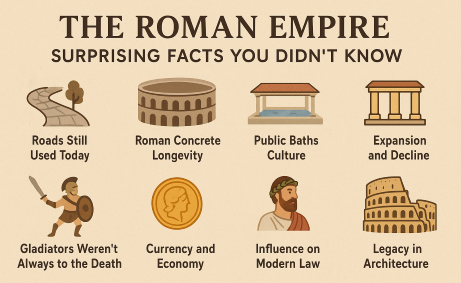Introduction
The Roman Empire remains one of the most influential civilizations in human history. From roads and laws to architecture and culture, Rome shaped the foundation of the modern world. While many people know about Julius Caesar, gladiator fights, and Roman legions, there are plenty of fascinating details that often go unnoticed. Here are 10 surprising facts about the Roman Empire that might change the way you look at history.
1. Roads Still Used Today
The Romans built a vast network of roads—over 250,000 miles long—many of which are still in use today across Europe. These roads were so well designed that they influenced modern highway construction.
2. Roman Concrete Longevity
Roman concrete, made with volcanic ash, lime, and seawater, has proven to be more durable than most modern concrete. In fact, many Roman structures like harbors and aqueducts are still standing strong after 2,000 years.
3. Public Baths Culture
Public baths were a major part of daily life in Rome. Citizens gathered not just to bathe, but also to socialize, exercise, and even conduct business. These baths reflected Rome’s emphasis on cleanliness and community.
4. Gladiators Weren’t Always to the Death
Contrary to popular belief, gladiatorial fights didn’t always end in death. Most gladiators were trained professionals, and their owners invested heavily in them. Killing every fighter would have been too costly.
5. Roman Aqueduct Engineering
Roman aqueducts were engineering marvels that transported clean water from mountains to cities. Some aqueducts stretched for dozens of miles and supplied water for drinking, baths, fountains, and even farms.
6. Currency & Economy
The Roman economy was one of the first to rely heavily on coinage. Silver denarii were widely used, and inflation became a problem when emperors began reducing the silver content in coins to fund wars.
7. Social Hierarchy
Roman society was highly structured. At the top were senators and wealthy elites, followed by citizens, freedmen, and slaves. Despite this rigid system, Rome allowed some social mobility through military service and trade.
8. Expansion & Decline
At its peak, the Roman Empire stretched from Britain to the Middle East. However, overexpansion, economic troubles, and internal conflicts eventually weakened Rome, leading to its fall in 476 AD.
9. Influence on Modern Law
Roman law laid the groundwork for many legal systems we use today. Concepts such as contracts, wills, and even the idea of “innocent until proven guilty” originated in Rome.
10. Legacy in Architecture
From the Colosseum to aqueducts and amphitheaters, Roman architecture remains a global inspiration. Features like arches, domes, and concrete construction continue to influence modern buildings worldwide.
Conclusion
The Roman Empire was more than just gladiators and emperors—it was a complex society that shaped our world in surprising ways. From advanced engineering to lasting cultural traditions, Rome’s influence is still felt today. By learning these fascinating facts, we can better appreciate the legacy of one of history’s greatest civilizations.




